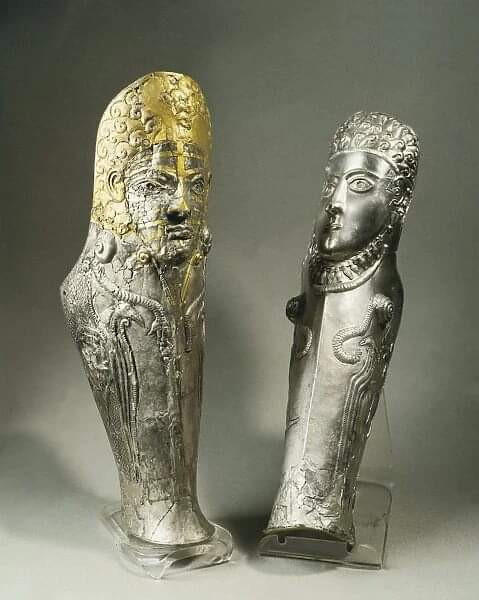In the northeastern region of Dobrogea, Romania, near the confluence of the Danube River and the Black Sea, a fascinating archaeological discovery has unveiled remarkable insights into the Geto-Dacian civilization. This ancient society, known for its cultural richness and historical significance, has long captivated historians and archaeologists. The unearthing of an extraordinary pair of silver and gold greaves, dated to approximately 400 BC, offers a deeper understanding of their artistic, spiritual, and societal practices.
These greaves, traditionally crafted as protective leg armor for warriors, demonstrate exceptional craftsmanship and provide a glimpse into the spiritual and ceremonial aspects of Geto-Dacian life. Unlike standard armor made from durable materials such as bronze or iron, these pieces are composed of softer metals—silver and gold—signifying that they were not intended for battle. Instead, they appear to have been used in rituals or grand ceremonies, symbolizing the profound cultural significance of such artifacts within the Geto-Dacian society.

Ceremonial armor holds a unique place in the study of ancient civilizations. While typical greaves served practical purposes on the battlefield, the Geto-Dacian greaves diverge from this norm. The choice of silver, a malleable and less resilient material, suggests their primary function was symbolic rather than protective. The inclusion of gold further underscores the wealth and status associated with these artifacts. Experts believe these intricately adorned greaves were likely worn by a high-ranking priest during religious ceremonies or military parades, underscoring the intersection of spirituality and social hierarchy in Geto-Dacian culture.
The discovery sheds light on the role of priests within the Geto-Dacian civilization. Archaeologists hypothesize that the owner of these ceremonial greaves was a figure of immense influence and respect, possibly serving as a trusted advisor to the king and royal family. This interpretation aligns with the broader understanding of the societal structure, where religious leaders often held dual roles as spiritual and political authorities. The lavish design of these artifacts highlights the importance of ceremonial regalia in reinforcing the authority and reverence bestowed upon such individuals.
Moreover, the intricate craftsmanship of the greaves reflects the advanced artistic capabilities of the Geto-Dacians. The detailed motifs and patterns etched into the silver and gold provide clues about their aesthetic preferences and spiritual beliefs. These designs likely held symbolic meanings, perhaps representing deities, natural elements, or cultural narratives. The craftsmanship not only demonstrates the skill of the artisans but also reveals the value placed on artistry as a medium for expressing identity and spiritual devotion.
The preservation of these artifacts offers a rare opportunity for researchers to delve deeper into the daily lives, beliefs, and artistic achievements of the Geto-Dacians. By studying the materials, designs, and contexts in which these greaves were found, archaeologists are piecing together a more comprehensive picture of this ancient civilization. The tomb where the greaves were unearthed has yielded additional artifacts that collectively enrich our understanding of the Geto-Dacian way of life. From pottery and tools to ceremonial objects, each discovery contributes to the broader narrative of their cultural and historical significance.
This archaeological find also underscores the interconnectedness of ancient societies. The Geto-Dacians, situated at the crossroads of various cultural and trade routes, likely interacted with neighboring civilizations, influencing and being influenced by their contemporaries. The silver and gold used in the greaves may have been sourced through trade or tribute, reflecting the economic and political dynamics of the region. Such interactions would have played a crucial role in shaping the cultural identity of the Geto-Dacians, as evidenced by the unique blend of local and external influences in their art and rituals.
The spiritual dimension of the greaves further enhances their significance. In ancient societies, ceremonial artifacts often served as conduits for connecting the mortal and divine realms. The greaves, adorned with symbolic motifs, likely played a role in rituals aimed at invoking divine protection, ensuring prosperity, or commemorating significant events. Their presence in the tomb suggests they were considered sacred possessions, perhaps accompanying the deceased priest into the afterlife as a testament to their spiritual journey and societal contributions.
The discovery of the silver and gold greaves is not merely an isolated event but part of a broader effort to uncover and preserve the heritage of the Geto-Dacian civilization. Each artifact unearthed adds a layer of complexity to our understanding of their culture, highlighting the sophistication and depth of this ancient society. The greaves, in particular, stand out as emblematic of their artistic ingenuity and the interplay between spirituality and social structure.
As archaeologists continue to study the tomb and its contents, they are uncovering a wealth of information that enriches the historical narrative of the Geto-Dacians. The findings provide valuable insights into their beliefs, rituals, and societal organization, offering a glimpse into the lives of a people who thrived in what is now modern-day Romania. These discoveries not only deepen our appreciation for the Geto-Dacian legacy but also contribute to the broader understanding of human history and cultural evolution.
The story of the silver and gold greaves is a reminder of the enduring legacy of the Geto-Dacian civilization. Through these artifacts, we are connected to a time when art, spirituality, and societal values were intricately woven into the fabric of daily life. The greaves serve as a testament to the creativity, devotion, and resilience of a people who have left an indelible mark on history.
In conclusion, the silver and gold greaves unearthed in Dobrogea are more than mere relics; they are a window into the rich tapestry of the Geto-Dacian civilization. Their intricate designs and luxurious materials tell a story of a society that valued ritual, spirituality, and symbols of power. As we continue to unravel the secrets of this ancient culture, these remarkable artifacts remind us of the shared heritage of humanity and the timeless pursuit of understanding our past. The preservation and study of such discoveries ensure that the legacy of the Geto-Dacians and their contributions to human history will endure for generations to come.





